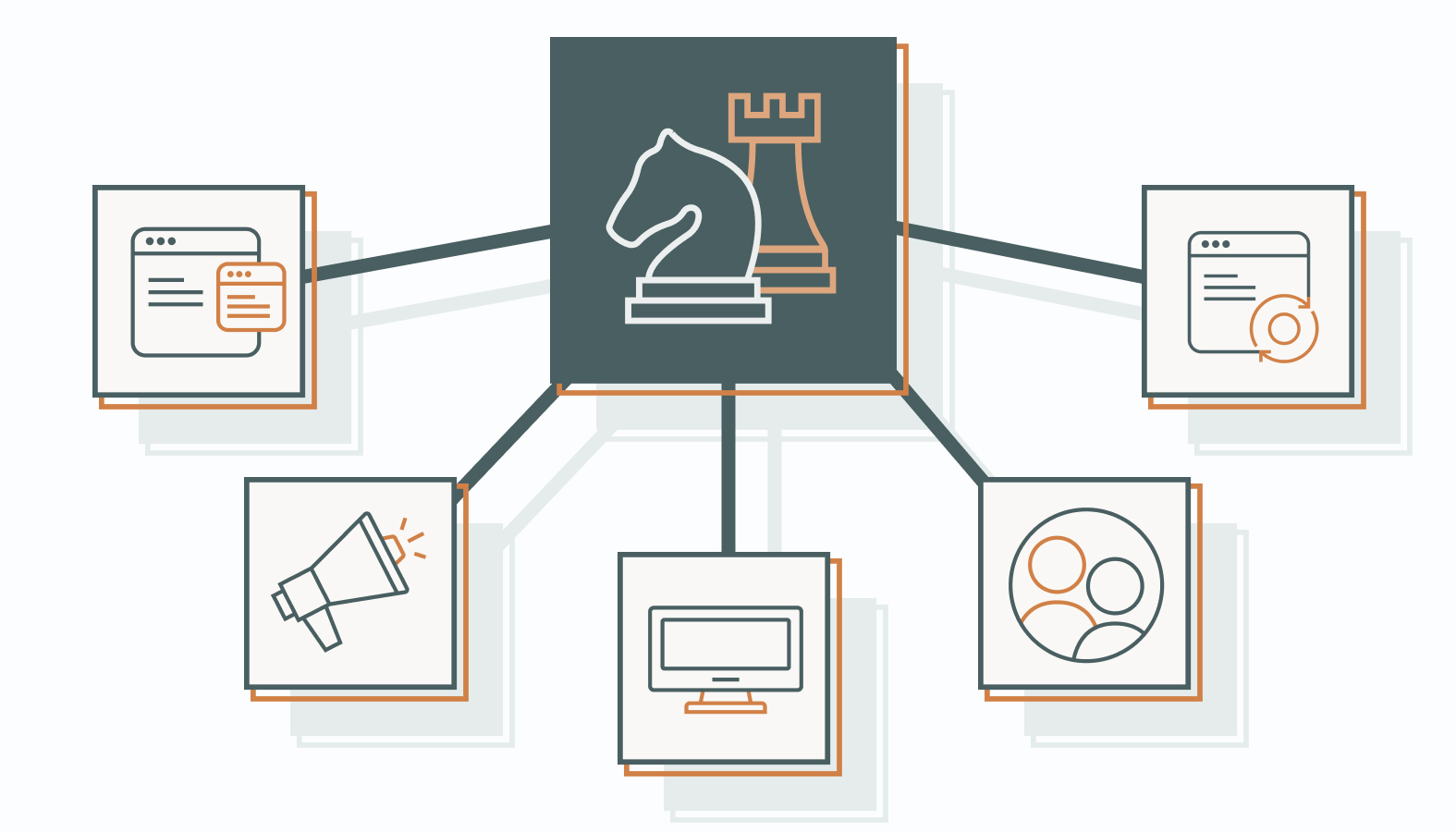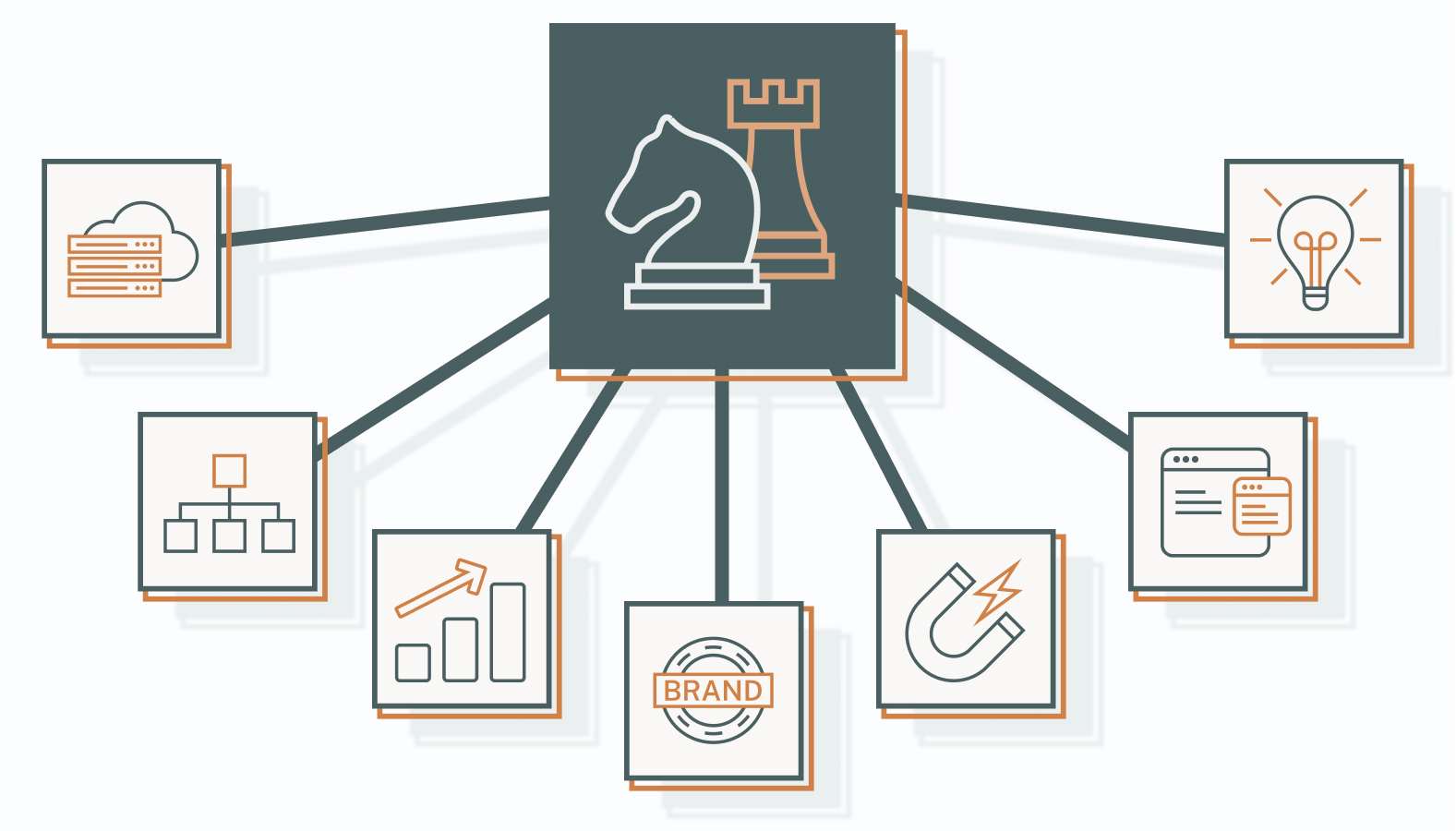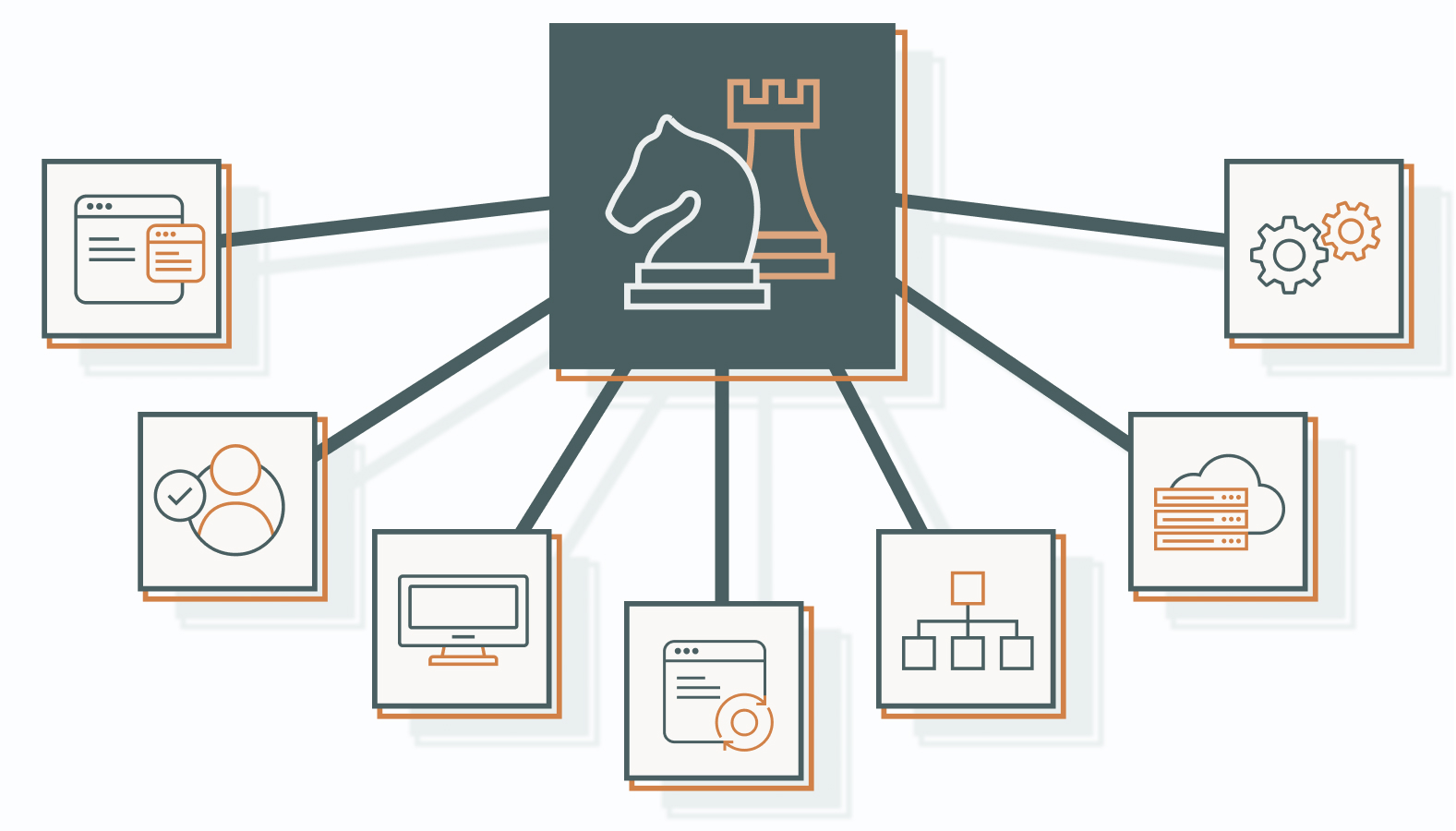Today, a solid understanding and implementation of a digital strategy is a necessity. Marketers, business leaders, and entrepreneurs are tasked with guiding their brands through the complex digital landscape. This comprehensive guide is your compass. Let’s dig in.
Digital Strategy: Definition and Context
A digital strategy is a carefully made plan to use digital tools to achieve business aims. As technology changes how we do things, this strategy is essential for enterprises to succeed. It’s the link between today’s technology and tomorrow’s market dominance.
Essential Components of Digital Strategy
A solid digital strategy connects what your brand could be to what it can achieve online. It’s a must for any company wanting to stay competitive in the digital marketplace. Let’s explore its key components.
Digital Marketing
Digital marketing helps companies make a brand more visible and engaging. Unlike traditional marketing, it is interactive and involves various methods like social media and email marketing. Using all these methods ensures a business stays consistent and supports its overarching business goals.
Advertising
Digital advertising offers a wide scope of options – from broad display ads to targeted pay-per-click (PPC) and subtle native advertising. Its strength comes from using customer data to personalize ads and employing analytics to make campaigns better at getting and keeping customers’ attention.
E-commerce
The rise of e-commerce has transitioned the focus to online stores. They must be well-designed and easy-to-use and should work well on mobile phones. A successful online store should make shopping enjoyable and hassle-free for customers.
Customer Interaction
CRM (customer relationship management) systems help businesses understand their customers and give them a more personalized customer experience. Today, customer feedback and reviews are highly influential, and businesses use this data to improve their offerings and solidify their online reputation.
Search Engine Optimization
SEO helps businesses stand out online by using the right keywords, optimizing their websites, and building links. It makes content more visible and ensures it resonates with both audiences and search engines.
Benefits of Creating a Digital Strategy
Today, a good digital strategy is more than just having an online presence. It assists many companies in dealing with the challenges of the digital world, interacting with customers, using resources wisely, and creating a powerful brand message.
Enhanced Data Collection
Collecting and analyzing data from many digital touchpoints is no small feat. It’s a strategic advantage a digital approach offers. This data helps businesses understand customer behavior, preferences, and emerging market trends to make their products and ads more personalized and well-suited to their customers.
Improved Asset Management
Digital strategies help manage online content and resources well, making sure the brand looks consistent and improving how customers interact with it. Using tech tools can integrate different online materials, while content management systems help streamline operations to get the most value out of digital investments.
More Effective Use of Resources
A cohesive digital strategy allows for smarter allocation of both human and financial resources. Businesses often spend less on digital marketing campaigns than on traditional methods because of how targeted and efficient they are. Automation also saves time, allowing teams to focus on more important work, like strategic thinking and innovation.
Increased Brand Recognition
Consistent branding online helps people recognize a brand more easily. A digital strategy ensures that every tweet, post, and banner share the same brand message.
Social media, in particular, can spread this message widely, helping a brand become more recognized and trusted. Strategic use of social media can even spread a brand’s message far and wide, more than traditional marketing ever could.
Improved Customer Engagement
Digital channels allow businesses to talk directly to customers. A digital strategy uses channels like social media and email to build better customer relationships. The feedback from these platforms enables organizations to improve their products and services based on what customers say.
Optimized Visibility and Reach
Visibility online is crucial, and a digital strategy helps with that. Through SEO, content marketing, and targeted digital campaigns, businesses can significantly enhance their visibility on search engines and social platforms. This allows them to reach a worldwide audience, enabling even small businesses to go global.
Data-Driven Decision-Making
Making informed decisions based on data is one of the biggest advantages of a digital strategy. Analytics tools show what’s effective and what’s not, allowing businesses to adjust quickly and keep up with what customers want. This agility is critical in maintaining a competitive edge and ensuring the business remains relevant.
Steps in Creating a Digital Strategy
Having a well-defined digital strategy is key to business success in this digital age. Since the online world is constantly changing, businesses need a good plan to navigate it successfully and maintain a competitive edge. Here’s a handbook for creating an effective digital strategy:
Establish the Objectives of the Strategy
To start a digital strategy, you need to have SMART (specific, measurable, achievable, relevant, and time-bound) goals. These should match the company’s mission and vision to ensure your digital efforts are headed in the right direction.
Prioritize them based on their potential impact and relevance to get the best results. These goals will support every decision and move you make online.
Clarify Your Brand Identity
Your brand’s identity online should be unique, recognizable, and a reflection of what your brand is all about. It isn’t just about your logo or color scheme but also about sharing your brand’s core message consistently across all digital touchpoints. This consistency helps shape how customers see and feel about your brand, leading to a strong brand image and customer loyalty.
Recognize Customer Channels
Understanding your target audience is critical. Create detailed buyer personas using data to identify the most effective channels for engagement. Use a mix of channels like social media, email, blogs, and corporate websites to reach them. This way, you’re more likely to get their attention and encourage them to buy or engage with your brand.
Formulate Flexible Business Processes
The digital landscape changes quickly, so your digital strategy should be able to change too. Create an environment where you always look to improve, take feedback seriously, and adopt it to refine your digital processes. Being able to evolve your strategy when needed keeps it relevant and effective.
Develop a Content Strategy
Content is key to connecting with customers online. An effective content strategy means creating and sharing valuable, relevant, and consistent content to attract and engage your target audience. Use a content calendar to schedule and manage your content, ensuring it’s timely and aligned with other marketing activities and digital business milestones.
Select Appropriate Tools
Pick tools that match your business targets and can grow with your business. Your toolkit could include data analysis and customer relationship management (CRM) systems that help you understand results, implement strategies, and measure outcomes effectively. Scalability ensures the tools can handle new demands and changes without constant updates.
The 7Ds You Need to Consider in Your Digital Strategy
A strong strategy focuses on the 7Ds, which are critical areas you must consider for a complete and effective digital presence and operation.
Digital Objectives
Digital objectives are what your business aims to achieve online and should be linked to your broader business goals. These objectives guide all your digital activities and help ensure they are focused and contribute to the overall growth of your business.
Digital Target Audiences
Understanding your target audience online is important. The online world is huge, and knowing who you’re trying to reach helps focus your efforts. By creating detailed buyer personas, you can tailor your strategies to meet the specific needs and preferences of these groups. This is crucial in crafting messages and campaigns that resonate, engage, and convert.
Digital Devices
A strategy that considers how people use different devices like smartphones, tablets, or desktops is essential. Providing a smooth experience across all these devices ensures the user’s online journey is enjoyable, regardless of the touchpoint. This requires making sure your website and content look and work well on any screen size customers might use.
Digital Platforms
There are many online platforms, such as social networks and online marketplaces. Selecting the right ones that fit with your company goals is crucial. Each platform has its strengths and weaknesses, and understanding these can help you create tailored content and campaigns that work well on each one.
Digital Channels
Using a mix of digital channels, including social media, email, search engines, and more, prevents you from depending too much on a single source for traffic and engagement. You can use social media for brand building and community engagement, email for personalized communication, and search engines for attracting intent-driven traffic.
Digital Data
Data is crucial for guiding your digital strategy. It helps you make informed decisions, refine your strategies, and better relate with your audiences. Having tools and methods to collect and assess data is essential, as they offer a clear picture of your performance, customer behavior, and market trends.
Digital Technology
Implementing a digital strategy needs the right technology to work. Using advanced digital technologies like artificial intelligence for customer service or blockchain for secure transactions can significantly enhance and bring new ideas to digital initiatives.
Examples of Digital Strategy in Real-world Contexts
Understanding the full potential of a digital strategy becomes clearer when you look at how it’s used in the real world. The following success stories highlight how digital innovation can make a big difference and deliver examples for others to follow.
Amazon – Personalization and Recommendation
Amazon has set the bar high with its use of advanced digital strategies to personalize shopping experiences. By analyzing vast amounts of customer data, it suggests products that fit each shopper’s interests, which helps them sell more and keeps customers coming back.
Its recommendation engine is a perfect example of how understanding customer preferences can increase sales and customer loyalty.
Netflix – Data-Driven Content Recommendations
Netflix has revolutionized the entertainment industry with its data-driven business model for content recommendation. It curates personalized content for each user by analyzing viewing patterns and user feedback. This keeps users engaged and less likely to cancel the service.
This strategy has established Netflix as a top choice for streaming, proving the power of data in content curation.
Starbucks – Mobile App and Loyalty Program
Starbucks’ digital strategy uses its mobile app and loyalty program to make ordering and payment easier and offer customers personalized rewards. This strategy not only improves customer service but also keeps people coming back.
Charting Business Success in the Digital Era
As we conclude our exploration of digital strategy, keep in mind that the way to succeed online is different for every business, just like each person’s fingerprint is unique. There isn’t a one-size-fits-all solution, but the key is to innovate a plan that fits your organization perfectly.
If the digital world seems overwhelming for you, fear not. We’re here to share insights, offer support, and explore possibilities with you. Schedule a candid conversation with us, and let’s talk about where you are, where you’d like to go, and how digital strategies can help you achieve your goals.









